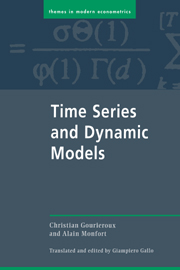Book contents
- Frontmatter
- Contents
- List of Adopted Notations
- Preface
- Chapter 1 Introduction
- Part I Traditional Methods
- Part II Probabilistic and Statistical Properties of Stationary Processes
- Chapter 5 Some Results on the Univariate Processes
- Chapter 6 The Box and Jenkins Method for Forecasting
- Chapter 7 Multivariate Time Series
- Chapter 8 Time-series Representations
- Chapter 9 Estimation and Testing (Stationary Case)
- Part III Time-series Econometrics: Stationary and Nonstationary Models
- Part IV State-space Models
- References
- Tables
- Index
Chapter 9 - Estimation and Testing (Stationary Case)
Published online by Cambridge University Press: 30 January 2010
- Frontmatter
- Contents
- List of Adopted Notations
- Preface
- Chapter 1 Introduction
- Part I Traditional Methods
- Part II Probabilistic and Statistical Properties of Stationary Processes
- Chapter 5 Some Results on the Univariate Processes
- Chapter 6 The Box and Jenkins Method for Forecasting
- Chapter 7 Multivariate Time Series
- Chapter 8 Time-series Representations
- Chapter 9 Estimation and Testing (Stationary Case)
- Part III Time-series Econometrics: Stationary and Nonstationary Models
- Part IV State-space Models
- References
- Tables
- Index
Summary
In chapter 6, we have presented the approach proposed by Box and Jenkins to analyze univariate time-series. This consists in deriving an ARMA or ARIMA model compatible with the data, in order to perform a number of diagnostic checks concerning the estimated model and to forecast future values of the series. In this chapter we address the issues related to statistical inference in a more rigorous fashion. Since the main results available concern the asymptotic behavior of the estimators, in section 1 we present some limit theorems which generalize the law of large numbers and the central limit theorem to the case of stationary processes. It is then possible to derive the asymptotic behavior of the empirical means, of the periodogram, of the empirical autocovariances and partial autocovariances.
In section 2, we discuss the maximum likelihood estimation of the parameters in a univariate time-series model. We check whether the classical sampling theory results still hold, that is whether the estimator is consistent, asymptotically normal, and its asymptotic variance is the inverse of Fisher's Information Matrix associated to the model. We give various forms of this matrix according to the representation (time domain, frequency domain, etc.) chosen to describe the series.
In the third section, we recall the main testing procedures currently used in statistics: the likelihood ratio, Wald, Lagrange multiplier (or score) tests. We develop in greater detail the latter type of test, which is often the simplest to use. We give a complete description of how this testing procedure is used in order to verify the hypothesis of white noise.
- Type
- Chapter
- Information
- Time Series and Dynamic Models , pp. 302 - 352Publisher: Cambridge University PressPrint publication year: 1996

